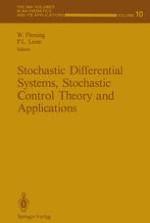This IMA Volume in Mathematics and its Applications STOCHASTIC DIFFERENTIAL SYSTEMS, STOCHASTIC CONTROL THEORY AND APPLICATIONS is the proceedings of a workshop which was an integral part of the 1986-87 IMA program on STOCHASTIC DIFFERENTIAL EQUATIONS AND THEIR APPLICATIONS. We are grateful to the Scientific Committee: Daniel Stroock (Chairman) WendeIl Flerning Theodore Harris Pierre-Louis Lions Steven Orey George Papanicolaou for planning and implementing an exciting and stimulating year-long program. We es pecially thank WendeIl Fleming and Pierre-Louis Lions for organizing an interesting and productive workshop in an area in which mathematics is beginning to make significant contributions to real-world problems. George R. Seil Hans Weinberger PREFACE This volume is the Proceedings of a Workshop on Stochastic Differential Systems, Stochastic Control Theory, and Applications held at IMA June 9-19,1986. The Workshop Program Commit tee consisted of W.H. Fleming and P.-L. Lions (co-chairmen), J. Baras, B. Hajek, J.M. Harrison, and H. Sussmann. The Workshop emphasized topics in the following four areas. (1) Mathematical theory of stochastic differential systems, stochastic control and nonlinear filtering for Markov diffusion processes. Connections with partial differential equations. (2) Applications of stochastic differential system theory, in engineering and management sci ence. Adaptive control of Markov processes. Advanced computational methods in stochas tic control and nonlinear filtering. (3) Stochastic scheduling, queueing networks, and related topics. Flow control, multiarm bandit problems, applications to problems of computer networks and scheduling of complex manufacturing operations.
